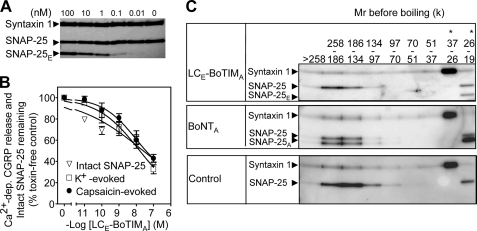FIGURE 6.
Inhibition of CGRP release from sensory neurons by LCE-BoTIMA: alteration of SNARE complex formation. A and B, rat TGNs cultured for 6 days were exposed to LCE-BoTIMA overnight at 37 °C; then release of CGRP was assayed over 30 min (24). The cells were solubilized in SDS sample buffer, and equal volumes were subjected to SDS-PAGE and Western blotting; the percentage of substrate remaining intact was calculated. A, immunoblot showing the cleavage by toxin of SNAP-25 but not syntaxin 1. B, dose-response curves for SNAP-25 cleavage and toxin-induced blockade of CGRP release evoked by 60 mm K+ or 1 μm capsaicin. All of the values are the means ± S.E. (n ≥ 3); in some cases, the error bars are encompassed by the symbols. C, after overnight incubation of TGNs with 100 nm toxin at 37 °C, the cells were stimulated with 1 μm capsaicin for 30 min before solubilization in SDS sample buffer without boiling and SDS-PAGE. Gel sections containing the proteins, separated according to their Mr or that of complexes as indicated, were extracted by boiling in SDS buffer before a second electrophoresis and Western blotting using antibodies as before (5, 25). Note that LCE-BoTIMA-truncated SNAP-25 was absent from the SDS-resistant SNARE complexes, unlike intact and BoNTA-cleaved SNAP-25. *, samples were diluted 5-fold before running in these lanes.

